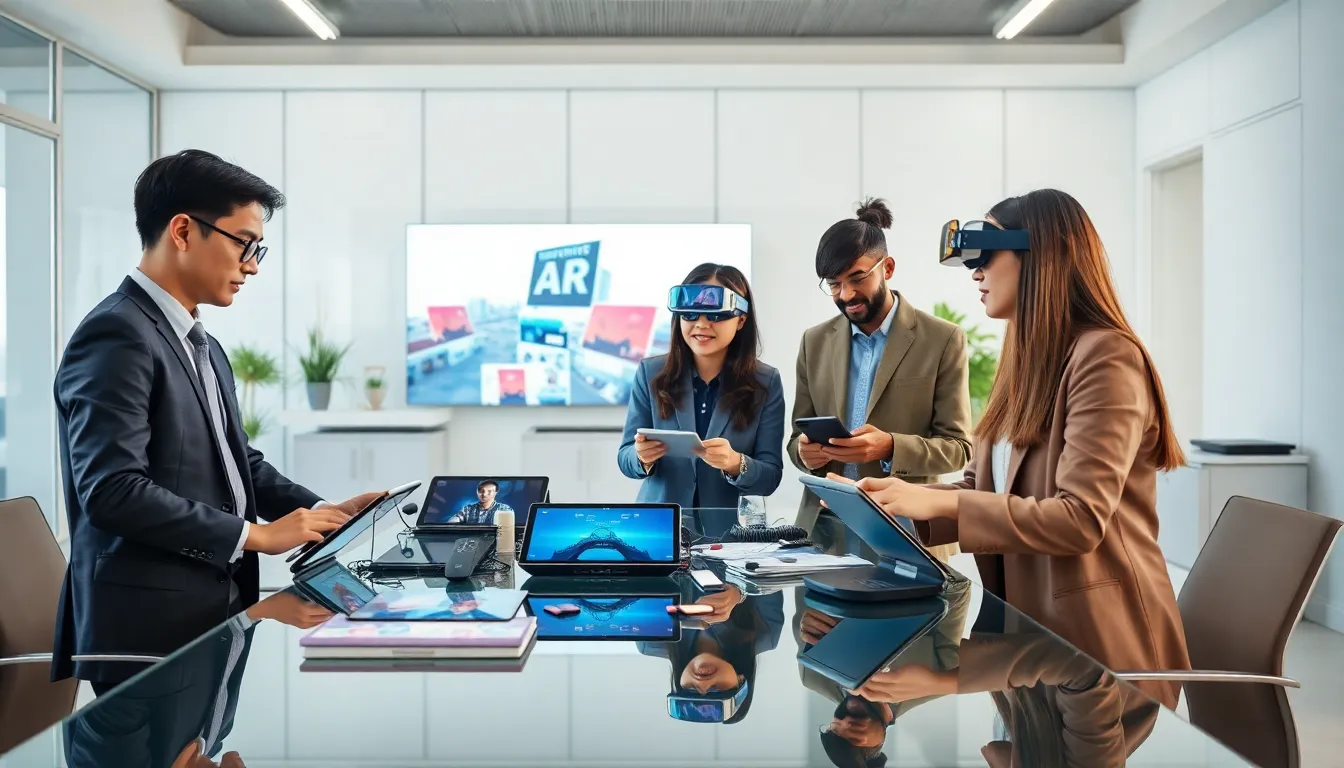Imagine walking through a museum and seeing holograms of historical figures explaining their significance. Sounds like a sci-fi fantasy? Welcome to the realm of augmented reality (AR). As technology continues to evolve, so does the demand for augmented reality app development companies. This article delves into the world of AR, its key features, top companies to consider for your project, and much more. So, grab your virtual goggles and let’s jump into this fascinating landscape.
Table of Contents
ToggleUnderstanding Augmented Reality Technology

Augmented reality technology blends the digital and physical worlds, allowing users to interact with computer-generated content in real-time. It overlays digital information, like images, sounds, and effects, onto the real world through devices such as smartphones, tablets, and AR glasses. Unlike virtual reality, which immerses users in a completely digital environment, AR enhances the real-world environment while maintaining user engagement.
The core of AR technology lies in its ability to recognize and respond to user input. This interaction can range from simple fun filters on social media apps to complex educational simulations in classrooms. In essence, augmented reality enriches the way users engage with their surroundings and opens up innovative avenues across various industries.
Key Features of Augmented Reality Applications
When it comes to augmented reality applications, several key features make them stand out in the tech landscape. Here are a few:
- Real-Time Interaction: AR applications provide immediate responses to user actions, enhancing the user’s experience by making it more intuitive and engaging.
- 3D Graphics Integration: High-quality 3D graphics are a hallmark of effective AR applications. They allow detailed visualizations that make digital content realistic and relatable.
- Environmental Awareness: Advanced AR applications use device sensors to understand and adapt to the physical environment, creating seamless interactions.
- User-Friendly Interfaces: Simplified navigation and intuitive controls make it easier for users to interact with augmented reality content without steep learning curves.
- Cross-Platform Compatibility: A significant trend in AR is the ability to function across various platforms, whether iOS, Android, or even web-based, ensuring accessibility for a broader audience.
These features not only enhance user engagement but also set the stage for AR technologies to transform industries, from education to retail.
Top Augmented Reality App Development Companies
With the rise of augmented reality, numerous companies have emerged as leaders in AR app development. Here’s a rundown of some of the top contenders:
- Niantic: Best known for the global phenomenon Pokémon GO, Niantic has elevated AR gaming. Their robust technology platform supports various AR experiences, from location-based gaming to social interaction features.
- Blippar: An innovative player in the AR space, Blippar develops applications that integrate machine learning and computer vision, allowing for dynamic AR experiences in advertising and education.
- Vuforia: Owned by PTC, Vuforia offers an extensive AR development platform for creating engaging industrial and consumer AR applications. Their tools ensure that brands can create immersive experiences effortlessly.
- Unity Technologies: This gaming engine powerhouse also excels in AR development, providing developers with the tools to create captivating interactive environments across many devices.
- Zappar: Specializing in branded augmented reality experiences, Zappar focuses on seamlessly integrating AR into marketing campaigns, helping brands connect with their audience creatively.
These companies not only lead the AR market but also bring innovative solutions that cater to various sectors, ensuring that businesses can leverage AR effectively.
Evaluating the Right Company for Your Project
Choosing the right augmented reality app development company for your project can feel overwhelming. Here are some crucial factors you should consider:
- Portfolio: A company’s previous work speaks volumes about its capabilities. Review their portfolio to assess their style, expertise, and the types of projects they have successfully completed.
- Industry Experience: It’s essential to choose a company that has experience in your specific industry. This ensures they understand your target market and can provide tailored solutions.
- Technology Stack: Investigating the technologies a development company uses is critical. Ensure they stay updated on the latest AR technologies and can create cross-platform applications.
- Client Reviews: Look for testimonials and case studies. Positive feedback from previous clients can indicate reliability and quality of service.
- Post-launch Support: AR applications require ongoing maintenance and updates. Ensure the company you choose provides dedicated support after launching your app.
By evaluating these factors meticulously, projects can lead to more successful applications that fulfill their intended purpose.
Case Studies of Successful Augmented Reality Apps
Several case studies highlight successful augmented reality applications that have made waves in their respective industries:
- IKEA Place: This app revolutionized furniture shopping by allowing users to place virtual furniture in their actual living spaces. Users can visualize how pieces will fit and look in their homes, vastly improving the shopping experience.
- Google Lens: A powerful image recognition app, Google Lens uses augmented reality to enhance user awareness about their surroundings. From translating text to identifying plants, its versatility showcases AR’s potential.
- Snapchat: Known for its fun face filters, Snapchat demonstrates how AR can create engaging social experiences. Users can interact with friends using various AR effects, making communication more playful and interactive.
- Wanna Kicks: This app allows users to visualize sneakers on their feet before making a purchase. By using AR technology, shoppers can decide if they like the shoes, enhancing confidence in their buying decisions.
- The Walking Dead: Our World: This mobile game utilizes AR technology to blend the fictional zombie universe into players’ real environments, creating thrilling interactive gaming experiences.
These case studies illustrate the broad applicability of AR across industries, showcasing how innovative apps can transform user interactions and experiences.
Future Trends in Augmented Reality Development
The future of augmented reality looks promising, with several trends likely to shape its development:
- Artificial Intelligence Integration: By merging AI with AR, apps will become more intuitive. For instance, recognizing user preferences could lead to personalized experiences.
- Wearable Technology: The advent of smart glasses points toward a future where AR could be woven seamlessly into daily life, requiring less reliance on smartphones.
- AR in E-Commerce: Retailers are increasingly adopting AR to enhance shopping experiences. Expect to see more try-before-you-buy features in online shopping.
- Immersive Learning: Educational platforms will leverage AR to create more interactive and engaging learning methods.
- 3D Mapping: Advances in AR will enable detailed mapping of physical spaces, enhancing navigation and situational awareness in various applications.
As technology continues to evolve, augmented reality will undoubtedly enhance interactions within many sectors, from entertainment to education and beyond.









